Trillion-dollar lunar bounty: The scramble to return to the moon
20 Jul 2019 ( IBTN News Bureau )Fifty years ago this week, Neil Armstrong became the first man to step onto the moon. Since then, only a dozen men have walked on the moon - the last in 1972.
Now, there is renewed interest.
China plans to build a lunar base by 2030 and NASA hopes to have men and women on the moon by 2024.
Over the next five years, the space agency is expected to spend $30bn on this. It is funding several projects from lunar landers to a mini-space station that will allow spacecraft to dock around the moon.
Billionaires Elon Musk and Jeff Bezos are also spending billions to get to the moon and Mars.
But there is a new emerging power. India is trying to become the fourth nation to land a probe on the moon.
The Chandrayaan-2 mission hopes to land a lunar rover close to the South Pole - a previously unexplored area - some time in September.
There, India hopes to find signs of water and helium-3. There is thought to be one million metric tonnes of helium-3 on the moon - each tonne estimated to be worth about $5bn.
Realistically, only about 250,000 tonnes of it could potentially be mined; but that would be enough to power the earth for at least two centuries.
The Indian Space Research Organisation's mission is expected to cost just $125m. India has built a reputation for its low-cost space exploration. Its budget of $1.7bn a year is just a tenth of NASA's $19bn.
Why is world hunger back on the rise?
The number of people going hungry has risen for the third year running after a period of improvement, the United Nations (UN) says.
The world body blames conflict, climate change, and an economic slowdown for the new uptick.
More than 820 million people, or 11 percent of the global population, suffer from hunger.
Africa has the highest numbers, with one in five people going hungry. In East Africa, the figure rises to nearly one in three people.
According to five UN agencies, more than two billion people worldwide cannot get safe, sufficient or nutritious food.
Big brands and the Muslim fashion industry
Burberry, Dolce & Gabbana and DKNY have all attempted to crack one of the fastest-growing markets - Islamic fashion.
What started as brands targeting wealthy Muslims with one-off fashion lines for religious occasions, has grown to a global trend for women who prefer to dress conservatively.
According to the Pew Research Center, Muslims are the world's fastest-growing major religious group. By 2050, it estimates there will be 2.7 billion Muslims worldwide, making up 29.7 percent of the global population.
And when it comes to the Islamic or modest fashion sector, spending is forecast to grow five percent annually to $361bn by 2023.
Turkey is the biggest spender on modest fashion: $28bn a year. This is followed by the United Arab Emirates (UAE) and Indonesia. But it is not a one-size-fits-all-trend; what is popular in Indonesia may not have the same appeal in the Middle East.
(Click here for Android APP of IBTN. You can follow us on facebook and Twitter)
Share This News
About sharing
-
 16 Sep 2025
UN inquiry finds Israel’s war on Gaza to be genocide
16 Sep 2025
UN inquiry finds Israel’s war on Gaza to be genocide
UN inquiry finds Israel’s war on Gaza to be genocide
-
 16 May 2025
Has Donald Trump taken US-Gulf relations to a new era?
16 May 2025
Has Donald Trump taken US-Gulf relations to a new era?
Has Donald Trump taken US-Gulf relations to a new era?
May 16, 2...
-
 16 May 2025
What do the Gulf states gain from the US president's historic trip to the region?
16 May 2025
What do the Gulf states gain from the US president's historic trip to the region?
What do the Gulf states gain from the US president's historic trip to the regio...
-
 15 May 2025
Pakistan FM: US didn't force the ceasefire with India | Talk to Al Jazeera
15 May 2025
Pakistan FM: US didn't force the ceasefire with India | Talk to Al Jazeera
Pakistan FM: US didn't force the ceasefire with India | Talk to Al Jazeera
-
 15 May 2025
How will the lifting of US sanctions help Syrians rebuild their country?
15 May 2025
How will the lifting of US sanctions help Syrians rebuild their country?
How will the lifting of US sanctions help Syrians rebuild their country?



